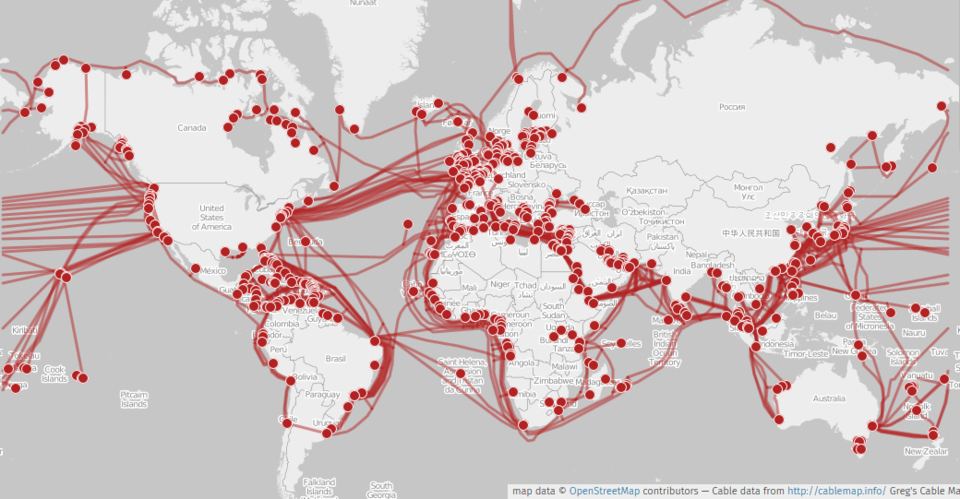
How are undersea Internet cables laid? Undersea Internet cables are basically laid by spooling them off a very large ship.
When you use the Internet, your computer has to somehow connect to the server where all of the information for whatever site you are searching for is stored. Those servers are in many different countries, but the chances are high that they are not in the country you are in. That means your electronic request for information has to travel across the sea from wherever you are to wherever the servers are. The digital communication does this by travelling through a very long cable that lies at the bottom of the ocean. There are currently 650 such cables, but more are being added every year, and they travel all over the Earth. The longest cable ever laid was called SEA-ME-WE 3. It was retired in 2024, but it was 39,000 km long. Meta has a plan to lay a 50,000 km cable that will go right around the Earth, but they haven’t started yet.
The cables that carry the Internet signals are fairly small, and they carry fiber optic cables. The average cable is about 2.5 cm in diameter. The cable has to have a lot of protection because of where it is. In the center are the fiber optic cables. They are surrounded by a petroleum jelly layer, which is wrapped in an aluminium tube. This is wrapped in a layer of tough plastic and then another layer of aluminium to keep the water out. This is surrounded by steel wires for strength and protection. Then there is a layer of mylar tape, and finally the whole cable is cased in strong polyethylene. The center of the cable uses fiber optics because it can transmit information as light pulses at very fast speeds. The cables are made of plastic, so the light is slowed down to about 70% of the speed of light in a vacuum, but it still travels very quickly. They can transmit huge amounts of data at the same time, up to 800 gigabytes a second. They also don’t corrode, and the data isn’t lost to interference. It would take a signal a fraction of a second to cross from Tokyo to San Francisco. The cables are attached to a cable landing station at each end, which connects them to the rest of the network.
These cables are incredible, but they have to get down there in the first place. They are laid by cable-laying ships that are about 150 m long. However, the first step is to plan the route. The whole length of the planned route has to be surveyed to make sure there is nothing there that could damage or hinder the cable. Even something like a large rock can cause problems. Once the route has been agreed on, the cable-laying ship loads up the cable and heads to sea. A kilometer of Internet cable weighs 1.4 tons. Most ships sail with about 10,000 km of cable, but they can carry more. The largest cable-laying ship currently in operation can carry 28,000 tons of cable, which at 1.4 tons per km is 20,000 km. The ships can stay at sea for several months. The cable spools out of the back of the ship as they sail and descends to the bottom of the ocean, which can be several thousand meters down.
Laying cables is not cheap, and a transatlantic cable can cost upwards of $250 million. They are laid by a number of companies, but these days, companies like Amazon, Google, and Meta are starting to get more involved with Internet cables. They need these cables to allow people to connect to their services.
An Internet cable is usually rated to last 25 years. They are periodically tested, and they can be fixed if they are broken by specialist ships. These ships lower down a hook to catch the cable, then they hoist it up to the ship where it can be fixed. The cables are at the bottom of the sea, but they can be damaged. They can be hit by vessels, unless they are very deep, and they can be damaged by things like undersea earthquakes and volcanoes. They also become obsolete and have to be replaced. As we use more and more data, the cables need more and more fiber optic cables. There is also the risk of sabotage. Countries spend money on the defense of their Internet cables, and they have plans for what to do in the event of a war. An island nation like Australia or Japan could be held hostage if an enemy force were able to cut their Internet connection. They would be effectively helpless. And this is what I learned today.
Sources
https://dgtlinfra.com/submarine-cables-fiber-link-internet
https://en.wikipedia.org/wiki/Submarine_communications_cable
https://en.wikipedia.org/wiki/Cable_layer
https://blog.telegeography.com/how-many-submarine-cables-are-there-anyway
https://www.submarinecablemap.com
https://www.bbc.com/news/articles/ckgrgz8271go
https://en.wikipedia.org/wiki/SEA-ME-WE_3
https://www.flukenetworks.com/blog/cabling-chronicles/what-is-fiber-optics
By cable data by Greg Mahlknecht , map by Openstreetmap contributors – http://www.cablemap.info (cable data by Greg Mahlknecht released under GPLv3)http://umap.openstreetmap.fr/de, CC BY-SA 2.0, https://commons.wikimedia.org/w/index.php?curid=42437752
